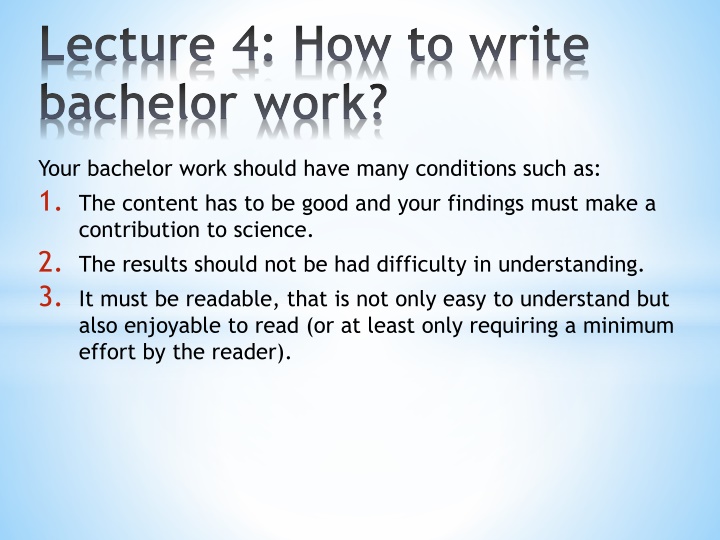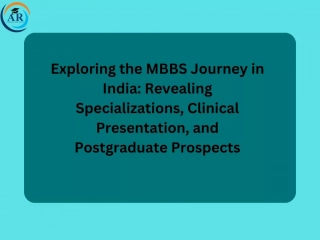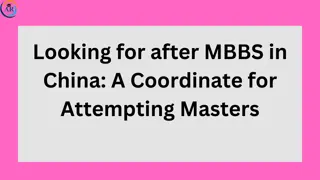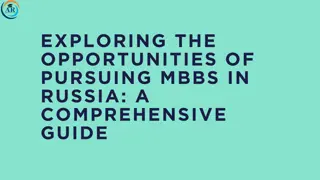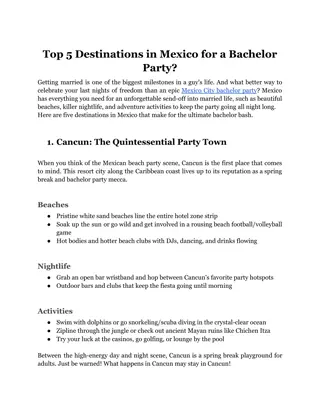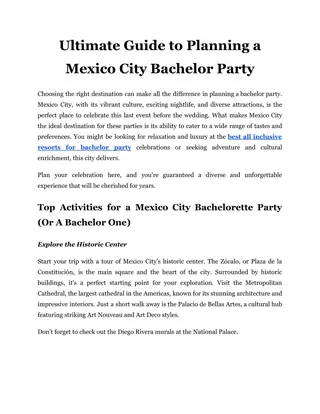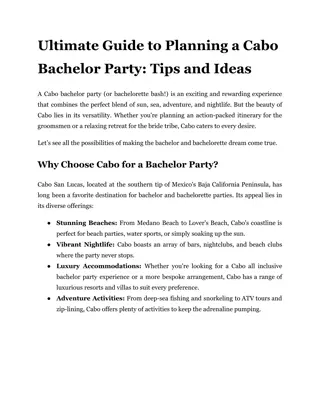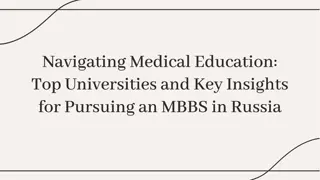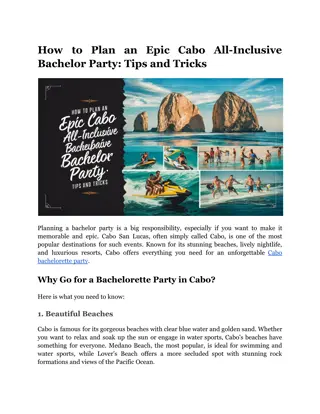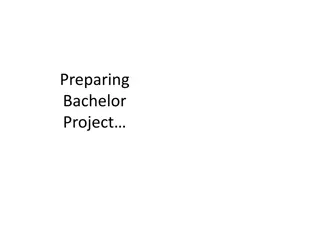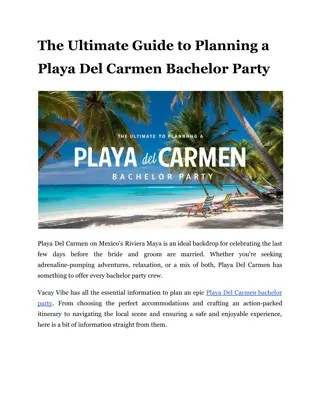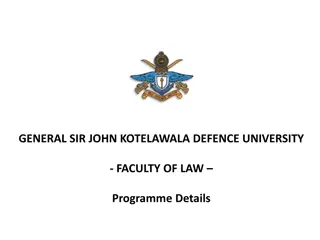How to Write Bachelor Work: Essential Tips for Success
Crafting a successful bachelor work involves meeting various criteria, such as contributing to science, ensuring clear results, and maintaining readability. Learn techniques to enhance readability, structure your paper effectively, and create a compelling abstract to capture attention.
Uploaded on Feb 15, 2025 | 0 Views
Download Presentation

Please find below an Image/Link to download the presentation.
The content on the website is provided AS IS for your information and personal use only. It may not be sold, licensed, or shared on other websites without obtaining consent from the author.If you encounter any issues during the download, it is possible that the publisher has removed the file from their server.
You are allowed to download the files provided on this website for personal or commercial use, subject to the condition that they are used lawfully. All files are the property of their respective owners.
The content on the website is provided AS IS for your information and personal use only. It may not be sold, licensed, or shared on other websites without obtaining consent from the author.
E N D
Presentation Transcript
Lecture 4: How to write bachelor work? Your bachelor work should have many conditions such as: 1. The content has to be good and your findings must make a contribution to science. 2. The results should not be had difficulty in understanding. 3. It must be readable, that is not only easy to understand but also enjoyable to read (or at least only requiring a minimum effort by the reader).
* You can improve the readability of your paper by: 1. You can improve the readability of your paper by: 2. having a clear and logical structure. 3. putting key information at the beginning of the paper, at the beginning of sections, paragraphs and even sentences. 4. reducing the amount that you write, and consequently reducing the amount the reader has to read. 5. only writing what the reader really needs to know (not everything that you know), and limiting the amount of background information. 6. using short sentences. 7. check your English.
*What are the contents (the structure) of bachelor work? Most scientific papers generally follow this structure: 1. Title (we will discuss this when talking about being concise) 2. Abstract 3. Introduction, ending with outline of the structure of the paper 4. Review of the literature (this section may be part of the Introduction) 5. What you did, your findings etc (Materials and Methods, Results and Discussion) 6. Conclusions - including plans for the future 7. Acknowledgements 8. Bibliography or references
*Abstract: An abstract is a mini version of your paper. It is your 'product', which you have to 'sell' to a referee. It is generally a very brief summary of each of the main sections (background, objective, materials and methods, results and conclusions). It is probably the most important part of a paper because if you want to publish it, it should enable: 1. A potential publisher to make a quick decision on whether the paper is relevant to his / her journal (without having to read the whole paper). Remember that referees have to review a lot of abstracts and papers. So, it is important to make your abstract stand out from the others in terms not only of scientific quality but also of how it is organized and what information it does and does not include
*Abstract: 2. A reader to identify quickly what the paper is about, to judge how relevant it is to their interests, and so to decide whether they should read the whole paper or not. 3. You to see whether you have really covered all the main points and whether your conclusions are substantiated and justified. An abstract will be judged in isolation from the paper, so it is vital for it to create a strong impression. Write a very rough draft before you start writing the paper itself as this may help you to decide what to include in the paper and how to structure it. But experienced writers always write the Abstract (and often the Introduction too) last, ie when they have finished the rest of the paper.
*An alternative, less traditional, structure: 1. Introduce the abstract with one or two sentences saying what you did + one key result, i.e. begin with info that the reader does NOT already know 2. Introduce the background by connecting in some way to what you said in your introductory sentence. 3. Use the background information (which the reader may or not already know) to justify what you did. Ensure that background details are not more than 40% of the abstract. 4. Provide some more information on your results. So, put statistics in your abstract. They give the idea of something specific and that you have done your work well. Avoid words like many / several / few when you could write something more specific. 5. Tell the reader the implications of your results and what you plan to do next.
* EXAMPLE Read this abstract Hydroxychloroquine (HCQ), the antimalarial drug, has been proposed as an effective treatment for Covid-19. In April 2020, the Food and Drug Administration warned service providers against using it because of its serious heart rhythm effects in the Covid-19 patients, but does HCQ cause heart rhythm just in Covid-19 patient or in every one? And why? So, this research aimed to demonstrate the impact of HCQ treatment on heart function by determined CK-MB and acetylcholine (ACH) levels in the healthy mice. Thirty adult male albino Balb/C mice, aged 2-3 months, were used in this study.
*These mice were divided randomly into three groups (n=10): (T1) treated with the high dose of hydroxychloroquine (8.1mg/kg body weight, 2-times for 10days), (T2) treated with the low dose of hydroxychloroquine (6.4mg/kg body weight, 2-times in the first day and then 1-time for 4days), while (C) is left without treated and served as a control group. Mice were sacrificed in different time points by cervical distraction. *The blood sample is collected from the eye and the Serum is separated to be used for CK-MB and Ach level determinations. Brain, spleen, and kidney were taken and homogenized to be used for Ach level determinations.
The results showed significantly higher CK-MB level in the T1 group compared to T2 and C groups and significantly higher ACH level in all studied tissues of both treated groups compared to control. These results indicate that HCQ could dangerously raise the heart rate even in non-Covid-19 patients, so caution and monitoring while using it are advised. Now read an analysis of the structure of the abstract. Look the matching of the explanations of what the author is doing with the extracts from the paper.
GOOD TRADITIONAL STRUCTURE SENTENCES FROM THE ABSTRACT TO MATCH TO POINTS 1-5 (HCQ), Hydroxychloroquine antimalarial drug, has been proposed as an effective treatment for Covid- 19. In April 2020, the Food and Drug Administration providers against using it because of its serious heart rhythm effects in the Covid-19 patients, cause heart rhythm just in Covid-19 patient or in every one? And why? So, this research aimed to demonstrate the impact of HCQ treatment on heart function by determined CK-MB and acetylcholine (ACH) levels in the healthy mice the 1) paper is trying to resolve. Why did you carry out your project and why writing this paper? The problem that this are you warned service but does HCQ .
Thirty adult male albino Balb/C mice, aged 2-3 months, were used in this study. These mice randomly into three groups (n=10): (T1) treated with the high dose of hydroxychloroquine (8.1mg/kg body weight, 2-times for 10days), (T2) treated with the hydroxychloroquine (6.4mg/kg body weight, 2-times in the first day and then 1-time for 4days), while (C) is left without treated and served as a control group. Mice were sacrificed in different time points distraction. The collected from the eye and the Serum is separated to be used for CK-MB and Ach level determinations. spleen, and kidney were taken and homogenized to be used for Ach level determiniations 2) authors of the paper. What is the innovative contribution of your work? What did you do? What makes it different from previous research? New solution given by were divided low dose of by cervical sample blood is Brain,
Does HCQ really do what you say it does? The higher CK-MB level in the T1 group compared to T2 and C groups and significantly higher ACH level in all studied tissues of both treated groups compared to control. results showed significantly What does this all mean? What are your conclusions and recommendations? What do you plan to do next? (option) These results indicate that HCQ could dangerously raise the heart rate even in non-Covid-19 patients, so caution and monitoring while using it are advised.
*Introduction and literature review It is the next part of your bachelor work or paper. A possible structure for it (though not necessarily in this order) is: 1. The background information, where appropriate, so that readers can understand and assess the results of your work without having to refer to the literature. NB this should be no more than 3-5 sentences long if you write paper but if you write bachelor work it could 3-5 paragraphs, otherwise readers will get frustrated because they want to contribution of your paper is and what new things they will learn. introduction which should has essential understand what the
*Introduction and literature review 2. Definition of the problem: why did you choose it? why is it important? what is the aim of the paper / what is your contribution to the problem? NB make sure you use the key phrase this paper describes or the aim of this paper is as near as possible to the beginning of the Introduction (i.e. within the first few sentences) 3. Review the literature (though this may be a separate section if you write bachelor work not paper) 4.method of investigation and why this was chosen.
*This section should be 1. 2. 3. not too long not just a cut and paste from the Abstract Objectives should well defined and the problem you are addressing or trying to solve should be clear. The background information should relate to the objective The reason for choosing a particular approach / methodology should be given and clear, so the reader can expect in the rest of the paper (i.e. main results and conclusions) and how this information will be structured (i.e. into the various sections) 4. 5. If the review of the literature is separated, it should be: 1. has made it clear why some references are mentioned - references must give support to what you are saying, they should not be there just to make your paper longer and seem more important has done a sufficiently wide literature search is aware of the state of the art has many references from work carried out in your own country 2. 3. 4.
*How to make reference to other authors? There are various ways of making reference to other authors. Style 1 is the shortest and easiest to read. The most tedious is Style 4. *STYLE 1: Evans (5) studied the differences between Italian and English. *STYLE 2: In (5), Evans studied the differences between Italian and English (Evans, 2012). *STYLE 3: The differences between Italian and English have been studied (5). *STYLE 4: A study of the differences between Italian and English is presented by Evans (5).
